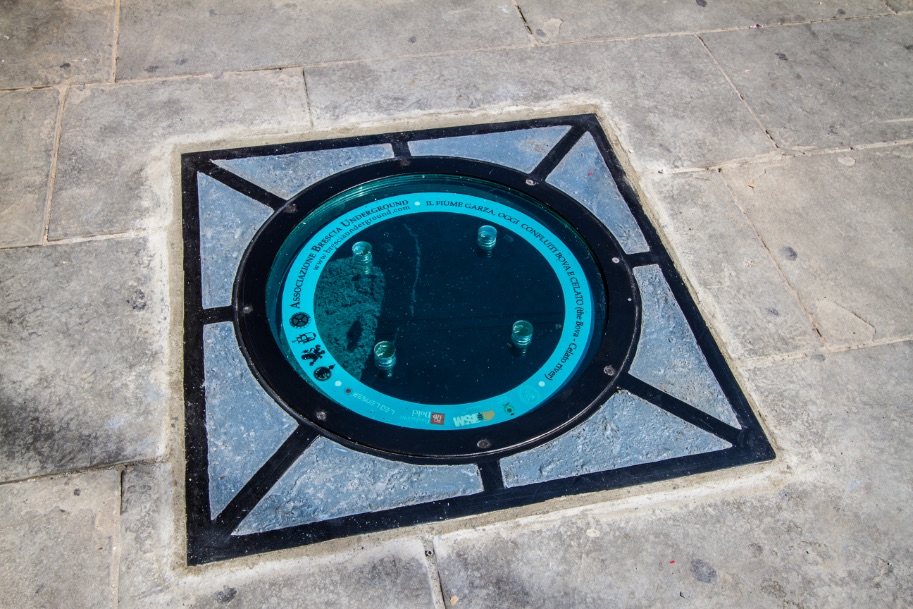IN THE CITY’S UNDERGROUND

Powered by Fondazione Dolci, Comune di Brescia, Consorzio Generale Federativo Utenze del Mella, Led Lenser.
Based on BRESCIAUNDERGROUND’s idea, october 2009.
Bresciaunderground APS decided to install 13 totems in the main streets of the city center. The totems are a tangible evidence of the great number of water flows wich are mostly concealed under the buildings, squares and monuments of the downtown area. For centuries, streams, underground passages and millraces traced the path and the changes of the city and, during preindustrial era, they enhanced our ancestor’s life and economy.
The 13 totems are located:
- Porta Pile, piazzale Cesare Battisti;
- Via Battaglie near Calini ai Fiumi building;
- Vicolo S. Faustino at the junction of contrada del Carmine;
- Via S. Faustino near the Ponticello’s square;
- Via Elia Capriolo at the junction of via S. Faustino;
- Contrada Pozzo dell’Olmo;
- Corso Garibaldi at the junction of via delle Battaglie;
- Largo Formentone (near Loggia’s square);
- Piazza della Vittoria on the side of S. Agata’s church;
- Via Fratelli Porcellaga at the junction of corso Palestro;
- Via Fratelli Dandolo at the junction of via Annibale Calini (Serraglio);
- Via Felice Cavallotti at the junction of corso Zanardelli;
- Via moretto at S. Domenico’s square.
Powered by Fondazione ASM / Gruppo a2a, Fondazione Dolci, Comune di Brescia, Comprensorio del fiume Celato, Led Lenser.
Based on BRESCIAUNDERGROUND’s idea, july 2013.
The Bresciaunderground APS had the one of a kind privilege to replace a pre-existent manhole cover with a new one made of tempered glass. This change was made to allow pedestrians to observe the flow of ancient rivers silently running where one couldn’t even imagine. The aim of association is to disclose a treasure of culture, history and interest and to show it up to the city of Brescia. During the middle ages, the leading force of the town was considered to be water. Today, the glass bring back to life the historic location of the Garza river, flowing through by Bova and Celato streams. At the very heart of the old city, where once mills and the first smart shop developed, today here’s a memory, a romantic tasting breach catching sight of the underground. This “urban eye” will allow both Brescia’s citizens and the tourists to overlook the story and remember a time when streams were completely unveiled.
Today, during the underground tour, our glass manhole has also become a fun and different way of interacting from below to above with the cheerful and surprised pedestrians, and vice versa.
TODAY BOVA AND CELATO RIVERS
Via S. Faustino 1B – 25122 Brescia

(19TH CENTURY)
The big picture inside the S. Faustino metro station, Brescia.

Based on a Bresciaunderground’s idea, june 2017.
Powered by OR.MA – Fondo Solidale Sociale Famiglia Mari Basso, Comune di Brescia, Brescia Infrastrutture, Brescia Mobilità, Metrobrescia, Valtrompiacuore, Fondazione Dolci, Fondazione della Comunità Bresciana, Led Lenser, CRE LO-VE Credito Lombardo Veneto
In the spot, the nineteenth-century bridge, of which you see on your left the southern arch of the eastern wall, allowed access to the city from the arch of Pile Gate (b&w photo). This system replaced the one drawn by Iseppo Cuman, which was part of the defensive layout of the venetian walls, which in this area allowed the river Garza to enter the city thanks to a weir in the moat and a series of arches in the counterscarp of the moat and in the city wall (respectively visible to your far right and behind you). In 1797 the Garza was diverted into the moat, and the arches toward the city were walled-in.